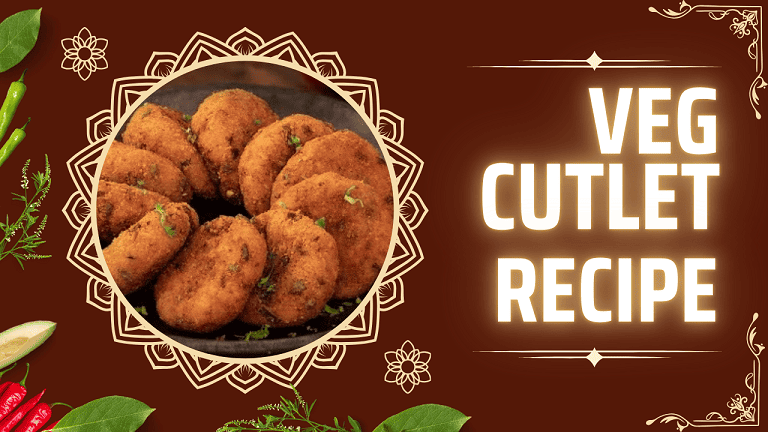Veg Cutlet Recipe
As an expert chef specializing in vegetarian cuisine, I’m excited to share my recipe for Veg Cutlet Kababs. These delightful kababs are not just a treat for the taste buds but also a nutritious option that can fit seamlessly into various meals.
Packed with vegetables and spices, Veg Cutlet Kababs are rich in vitamins, minerals, and fiber, making them a healthy choice for all ages.
These kababs are a popular street food in India, often enjoyed as snacks or appetizers. Their crispy exterior and soft, flavorful interior make them a favorite among vegetarians and meat-lovers alike.
What’s more, they are incredibly versatile, allowing for various substitutions and adjustments based on local ingredients and dietary preferences.
In this recipe, we’ll use fresh, locally sourced ingredients available around India, ensuring that your kababs not only taste great but also support local farmers and sustainable practices.
Health Benefits
Veg Cutlet Kababs offer numerous health benefits:
High in Fiber: The use of vegetables and legumes provides a good amount of dietary fiber, aiding digestion.
Nutrient-Rich: These kababs contain various vegetables, offering essential vitamins and minerals.
Protein-Packed: Using legumes like chickpeas or lentils boosts the protein content, making them filling.
Low in Calories: When baked or shallow-fried with minimal oil, they can be a low-calorie option for those watching their weight.
Ingredients
For the Cutlet Mixture
- Potatoes (Aloo): 2 large, boiled and mashed (about 300g)
- Carrots: 1 medium, finely grated (about 50g)
- Green Peas: 1 cup, boiled and mashed (about 150g)
- Spinach: 1 cup, blanched and chopped
- Onion: 1 medium, finely chopped (about 100g)
- Ginger: 1 inch piece, grated
- Green Chilies: 2, finely chopped (adjust to taste)
- Coriander Leaves: ¼ cup, finely chopped
- Cumin Powder: 1 tsp
- Garam Masala: 1 tsp
- Salt: To taste
- Lemon Juice: 1 tbsp
For Coating
- Bread Crumbs: 1 cup (use whole wheat or gluten-free, if preferred)
- Rice Flour or Cornstarch: 2 tbsp (for a crispier texture)
- Oil: For shallow frying (or baking, if preferred)
Step-by-Step Instructions
Step 1: Prepare the Vegetables
Boil the Potatoes: Peel and boil the potatoes until fork-tender. Drain and mash them in a large bowl.
Grate and Chop: Grate the carrot and chop the spinach and onion finely. If using fresh peas, boil them until soft and mash lightly.
Combine the Vegetables: Add the grated carrot, mashed peas, chopped spinach, onion, ginger, and green chilies to the mashed potatoes.
Step 2: Season the Mixture
Spice it Up: Add cumin powder, garam masala, salt, and lemon juice to the vegetable mixture.
Add Freshness: Incorporate the chopped coriander leaves. Mix everything well until evenly combined. The mixture should be firm enough to hold its shape. If it feels too soft, add a little more mashed potato or breadcrumbs.
Step 3: Shape the Kababs
Form the Cutlets: Take a small portion of the mixture (about 2 tablespoons) and shape it into a round or oval patty. Repeat until all the mixture is used up.
Coat the Cutlets: In a shallow plate, mix the bread crumbs and rice flour. Coat each cutlet with the breadcrumb mixture, ensuring even coverage. This adds crunch to the kababs.
Step 4: Cooking Options
Option 1: Shallow Frying
Heat Oil: In a large skillet, heat about 2-3 tablespoons of oil over medium heat.
Fry the Kababs: Once the oil is hot, carefully place the kababs in the pan. Fry for about 3-4 minutes on each side or until golden brown and crispy. Avoid overcrowding the pan to ensure even cooking.
Option 2: Baking
Preheat the Oven: Preheat your oven to 200°C (400°F).
Prepare a Baking Sheet: Line a baking tray with parchment paper and lightly grease it.
Bake the Kababs: Place the coated kababs on the tray and spray or brush them lightly with oil. Bake for about 20-25 minutes, flipping halfway, until they are golden brown and crispy.
Tips for Preparing and Cooking the Vegetables
Blanching Spinach: To retain the bright green color and nutrients, blanch spinach in boiling water for 2-3 minutes, then transfer it to cold water immediately. This method preserves its vibrant color and nutrition.
Boiling Potatoes: For best results, boil potatoes with the skin on to retain nutrients. Peel them after boiling for easier handling.
Chopping Vegetables: Ensure the vegetables are finely chopped or grated to help them blend well in the mixture, resulting in evenly textured kababs.
Variations and Substitutions
Vegetable Options: Feel free to add or substitute other vegetables like bell peppers, zucchini, or even grated beetroot for a pop of color.
Legume Base: Instead of potatoes, you can use cooked chickpeas or lentils for added protein. Simply mash them and mix with the vegetables.
Spices: Experiment with different spices like chili powder or turmeric for varied flavor profiles.
Gluten-Free: Use gluten-free breadcrumbs and rice flour to make this recipe suitable for gluten-sensitive individuals.
Serving Suggestions
Chutneys: Serve the Veg Cutlet Kababs hot with an assortment of chutneys like mint chutney, tamarind chutney, or yogurt sauce for added flavor.
Salad: Accompany them with a fresh salad of sliced cucumbers, tomatoes, and onions to balance the meal.
Buns: For a complete meal, you can use the kababs as filling for burgers or wraps.
Presentation Tips
Plating: Arrange the kababs on a colorful plate. Garnish with fresh coriander leaves or mint for a pop of color.
Accompaniments: Serve with small bowls of chutney and lemon wedges on the side for a delightful presentation.
Add Color: Include colorful vegetable sticks (carrots, cucumbers, bell peppers) on the side to enhance the visual appeal of your dish.
Conclusion
Veg Cutlet Kababs are a versatile and nutritious option that everyone will love. By using fresh, locally sourced ingredients, you not only create a delicious dish but also support local farmers and sustainable practices. Whether as a snack, appetizer, or main course, these kababs are bound to impress your family and friends.
Enjoy the process of cooking and experimenting with flavors, and don’t hesitate to make this recipe your own. Happy cooking!
Thanks for visiting Veg Recipe

